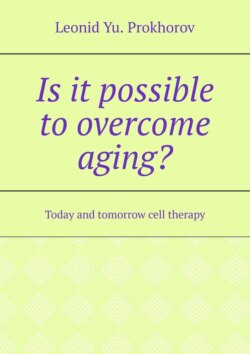Читать книгу Is it possible to overcome aging? Today and tomorrow cell therapy - Leonid Yu. Prokhorov - Страница 6
METHODS OF SKIN REJUVENATION
ОглавлениеIn order to correct age-related changes in the skin, there is a variety of currently used methods (peels, polishing, lifting, etc.) and preparations (toxin of botulism, components of extracellular matrix and connective tissue, etc.). Many of these methods are aimed at stimulating skin cells, in particular fibroblasts. However, it can be possible to solve the problem in
another way – by increasing the number of fibroblasts in the skin by means of transplanting them to the places where needed.
Before transplantation of fibroblasts became a reality, researchers had to solve many methodological questions, including those of safety of similar procedures.
Significant progress has been achieved in this regard when researchers became able to cultivate the cells, i. e. maintain the viability of fibroblasts outside the body, or in other words in vitro. In 1961, L. Hayflick and P. S. Moorhead (Hayflick, Moorhead, 1961) reported that even under optimal conditions of in vitro cultivation, human embryo fibroblasts were only capable of dividing a limited number of times (50 ± 10). In subsequent studies, this observation was repeated many times. The last phase in the life of cells in culture hase been identified as cellular senescence, and the phenomenon received the name of the author as Hayflick limit.
After the establishment of Hayflick limit and as a result of numerous studies, it was found that normal fibroblasts in culture retain a diploid karyotype and have a limited life expectancy. In addition, normal cells lack oncogenic potency. These requirements to cultures of normal cells were issued in the form of normative documents.
If these requirements are met, it is possible to use human fibroblasts cultivated outside the body for the production of immunobiological prepartions, and then for therapeutic purposes. Scientific research and clinical developments in this area are very intensive, due to general rise of cellular technologies based on stem cells.
Currently, there are two main approaches to the treatment of skin with preparations containing live fibroblasts. On the one hand, methods and preparations for the treatment of skin defects due to wounds and burns became widely known with the help of cultures of allogenic (from another organism) embryonic fibroblasts. An alternative to these methods is the possibility of using autologous (a person’s own) human fibroblasts for cell replacement therapy of the skin (Zgursky, 2004).
It is believed that the best results of cell therapy are obtained by using cultures of embryonic fibroblasts, which have a greater proliferative potential than cultures from adult donors. However, the use of cells derived from embryos has a number of limitations, including ethical ones. At the same time, data accumulate that a person’s own fibroblasts retain their potential during aging, despite a decrease in their number in the aging organism (Terekhov, 1984).
To achieve primary results, it is necessary to obtain fibroblast cultures from adult donors. It was found that proliferative abilities of the fibroblasts obtained (in comparison with embryonic skin fibroblasts) are sufficient to use them for cell therapy (Zgursky, 2004).
